Cecilia Casadei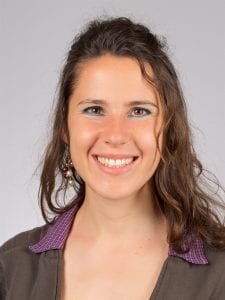
After concluding her studies in Solid State Physics, Cecilia obtained her PhD working on the determination of protonation states in enzyme reaction intermediates using neutron cryo-crystallography. She then developed her interest in algorithm development for novel structural biology methods and focused on data processing techiques for the analysis of serial diffraction images obtained from two-dimensional membrane protein crystals exposed to Free Electron Laser X-ray pulses. She collaborates with Prof. Ourmazd group to develop new methods aimed at the analysis of time-resolved serial crystallography data affected by sample heterogeneity and timing uncertainty.
o
o
o
Eduardo Cruz Chu
Currently, Eduardo is a postdoctoral researcher working on X-Ray Free Electron Laser (XFEL) data processing under the supervision of Prof. Peter Schwander. In principle, the femtosecond x-ray pulses used in XFEL experiments should allow researchers to resolve not only new biomolecular structures but also short-lived structural intermediates which in turn can be used to assemble dynamic images and energy landscapes of biomolecules.
Eduardo has an extensive educational and professional background. He was a postdoctoral researcher at the Swiss Federal Institute of Technology Zürich (ETHZ) and the Heidelberg Institute for Theoretical Studies (HITS) and obtained a Ph.D. in Biophysics at the University of Illinois at Urbana Champaign (UIUC). As an undergraduate, he studied a double major in Chemistry and Applied Mathematics from the Universidad Peruana Cayetano Heredia (UPCH), where he also held a research faculty position in the Chemistry Department before joining Prof. Peter Schwander’s group.
o
o
o
Raison Dsouza
Raison is currently pursuing a post-doctoral research in Prof. Ourmazd group with focus on machine learning techniques for spatiotemporal analysis of data from ultrafast time-resolved experiments.
Raison received his PhD in Physics from the University of Hamburg, Germany. The research was conducted at the Max Planck Institute for the Structure and Dynamics of Matter (MPSD) in Hamburg. His work involved benchmarking excited state electronic structure methods and extending its application to aid in understanding ultrafast molecular dynamics. His interests span from ultrafast multidimensional spectroscopy and quantum nuclear dynamics to protein-ligand/protein-protein interactions. He has also spent time developing virtual-reality based (OpenVR) applications to enable interactive data exploration.
o
o
o
Roshanak Etemadpour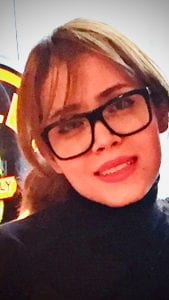
Roshanak is a PhD holder in Atomic and Molecular Physics from the Plasma Physics Research Center of IAU, Science and Research Branch in Tehran/IRAN. She also holds a Master of Science in Photonics from Tabriz University/IRAN. She is a skilled researcher in nonlinear Laser Pulse – Plasma Interaction Phenomenon, Quantum Optics, and Quantum Interference-related Phenomena, Optically Controllable Switching between Subluminal / Superluminal propagation.
Roshanak has 10 years of teaching experience in different universities of IRAN as a Lab, Mathematics, and Physics instructor. As a non-academic work, she has been involved and has been working as a Research Scientist for more than 5 years in different data analytics projects to build Statistical Models for Behavior Prediction of different systems. During that period, she gradually got interested in real-world and natural system modeling using Machine Learning/Statistics, so she joined Prof. Ourmazd’s group to pursue her academic career in Biophysics.
o
o
o
Russell Fung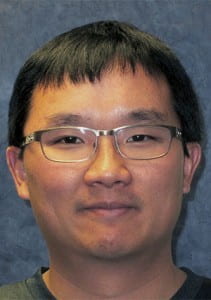
Russell is an algorithm developer with over 20 years experience coding Fortran, C, and MATLAB. His expertise includes x-ray diffraction, manifold embedding, numerical analysis, linear algebra and optimization. Codes he developed are used in various research groups in Hong Kong and Wisconsin, as well as in the control/ analysis software of commercially available two-photon microscopes for which he holds two US patents. Russell has a double major in Mathematics and Physics (Queensland Australia), and various postgraduate degrees in Physics (Hong Kong, Wisconsin). His interests include the dynamics of bond-breaking in diatomic molecules, the fingerprints in the cosmos left by the Big Bang explosion, and everything in between.
o
o
o
Ahmad Hosseinizadeh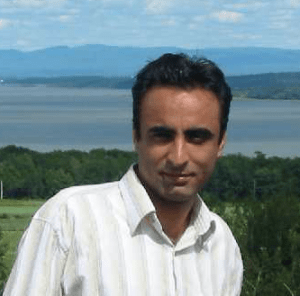
Ahmad’s research covers different topics in structural biophysics with X-ray diffraction. Over the past few years, he has worked on algorithmic developments for structural determination of biological entities, such as viruses, using single-particle X-ray free electron laser data collected at the LCLS. He is also involved in the data analysis team of the X-ray single-particle imaging program, coordinated by SLAC National Laboratory at Stanford. His current work is to develop a novel data-analytical technique to study the oxygen-evolving center of photosynthesis using X-ray emission spectroscopy. Ahmad has a doctoral degree in theoretical and computational physics from Laval University in Canada and a master’s degree in physics from the Institute for Advanced Studies in Basic Sciences in Iran.
o
o
o
Ghoncheh Mashayekhi
Ghoncheh Mashayekhi, is an experienced biomedical engineer with a PhD from Sharif University of technology. Her expertise is in algorithm development for biological data processing utilizing different signal/image/data processing, machine learning and modeling techniques. After working in R&D department of a healthcare company on multiple physiological measurement modules and embedded real time systems, she joined Prof. Ourmazd’s group. During this time, she has worked on developing advanced algorithms to extract the continuous conformational changes of a virus from Single Particle X Ray Free Electron Laser scattering. Currently she is working on Cryogenic Electron Microscopy images of macromolecular complexes to map the conformational landscapes controlling the biological processes.
o
o
o
Peter Schwander
Peter Schwander is currently an Associate Professor at UWM. His interests concern structure and dynamics of macromolecular assemblies, molecular machines, single-particles methods using X-ray Free-Electron Lasers and cryo-Electron Microscopy, data mining of large data sets by Manifold Embedding and 3D Tomography.
Peter Schwander graduated with his PhD in Physics from the Swiss Federal Institute of Technology Zürich (ETHZ), the most prestigious university in Switzerland, and completed postdoctoral studies at AT&T Bell Laboratories in New Jersey. Dr. Schwander returned to Switzerland after completing his postdoctoral work and then joined IHP, a Leibniz Institute for Microelectronics in Frankfurt (Oder), Germany before joining UWM.
o
o
o
Joanna Slawinska
Joanna has a comprehensive multidisciplinary background, including a Masters degree in Physics with a focus on theoretical astrophysics and stellar pulsations, a PhD in Computational Fluid Dynamics for geophysical flows, and postdoctoral research training in Applied Mathematics. Joanna is a postdoctoral associate working on a range of topics, from theoretical development of data-driven methods for dynamical systems, to their subsequent application to various fields of physics. In particular, the current focus of her work is on machine learning techniques for analysis of spatiotemporal patterns of ultrafast spectroscopical data, complex turbulent flows, and more to come.
o
o
o
Former Group Members:
Guillaume Castex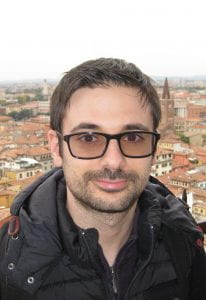
Guillaume is a postdoctoral researcher using machine-learning techniques applied to astronomy. He did his Ph.D. in the Astroparticule et Cosmologie laboratory, Paris, France, where he worked on numerical simulations for the Planck collaboration. He subsequently went to the SISSA research center in Trieste, Italy, as a research associate, before joining UWM. His research interests include machine-learning, cosmology, data-analysis techniques.
o
o
o
Jeremy Copperman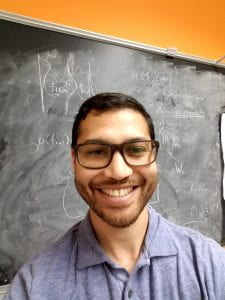
Jeremy is a postdoctoral research associate studying the dynamics of viruses using single-particle imaging data, such as those produced at X-ray Free Electron Laser sources, with Dr. Peter Schwander, and Dr. Abbas Ourmazd. Current projects include the development of new methods to extract the governing forces underlying biological structural pathways, combining non-equilibrium statistical mechanics with large-data manifold learning techniques. Jeremy received his PhD in physics from the University of Oregon in 2016, studying protein dynamics in the group of Dr. Marina Guenza. General research interests regard studying the general laws driving the complex phenomenology of biological systems spanning microscopic fluctuation to macroscopic evolution. He is passionate about reveling in life together with his family and friends.
o
o
o
Ali Dashti
As a research scientist, Ali’s regular duties involve computing with large Graphical Processing Unit (GPU) Clusters and perform critical calculations supporting Ourmazd group’s work in the projects currently funded by the U.S. Dept. of Energy; and the National Science Foundation (NSF), including the NSF Science and Technology Center (STC) award. Ali has the lead role in a project aimed at mapping continuous conformations and energy landscapes of molecular machines using Cryo-Electron Microscopy. During 2015, he established the approach, published in November 2014 in PNAS, by extending the initial work to different datasets. This work is a critical part of a growing number of collaborations. In addition, he helped other members of the group in applying what he has developed for Cryo-EM to X-ray Free Electron Laser (XFEL) single-particle analysis.
o
o
o
Imene Goumiri
Imene Goumiri has earned her MA and PhD in Mechanical and Aerospace Engineering from Princeton University. She has many years of experience at the Princeton Plasma Physics Laboratory (PPPL) and at the Madison Symmetric Torus (MST) in the field of magnetic confinement of fusion plasmas, where she developed models and control design tools that were embedded in real time to the fusion experiments. She joins Prof. Ourmazd’s group as a post-doctoral research associate to utilize and yet improve her data analysis and machine learning skills.
o
o
o
Reyhaneh Sepehr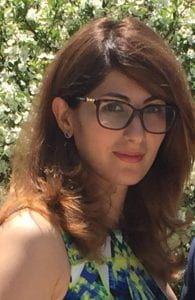
Reyhaneh is currently a postdoctoral research associate working on extracting ultrafast dynamics of proteins from XFEL data. She has received her Bachelor’s and Master’s in biomedical engineering from Amirkabir University of Technology in Tehran. After working in industry for a few years, she returned to academia to attain her PhD in electrical engineering at UWM. Her main research interests are machine learning, pattern recognition, signal and image processing, and their applications in biology towards a better understanding of biological systems.
o
o
o